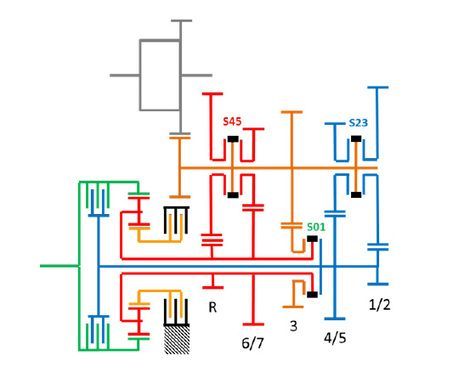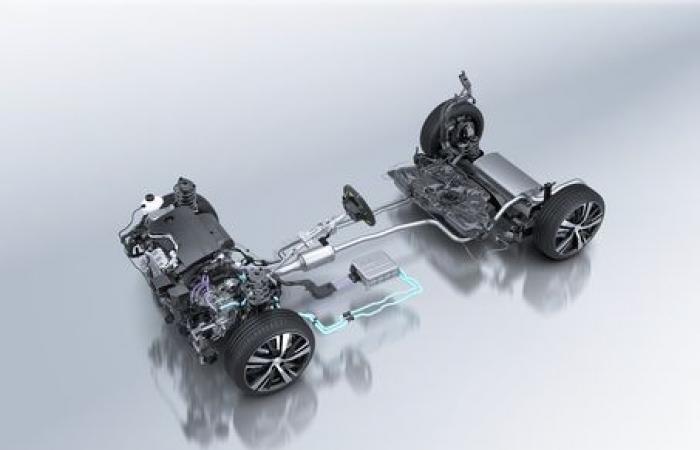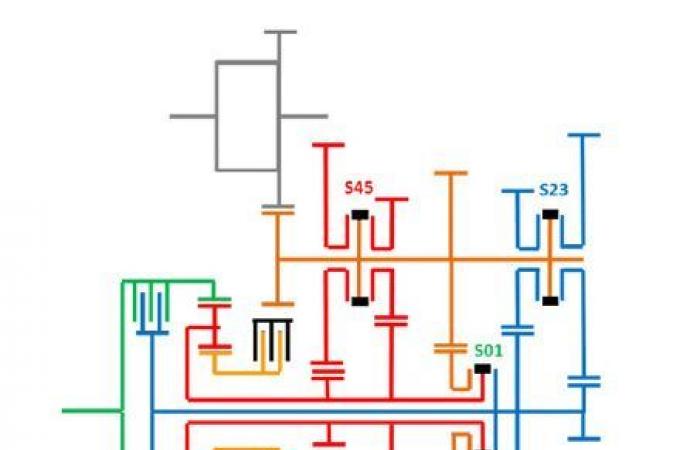For a few months now, Stellantis has been offering almost its entire range with a new hybrid engine. Its special feature is that it features a small 48-volt electric motor, supplied by Valeo and also used by the Citroën Ami. This appears to be much less expensive than the high-voltage ones from Toyota, Honda or Hyundai. However, the French manufacturer promises that this new engine can run on electric power for a few hundred meters… Which is impossible on almost all low-voltage hybrids offered by other manufacturers. The best of both worlds, in short!
Read alsoPeugeot 3008 Hybrid 48 Volts Review: Very Pleasant to Drive, But It Consumes Fuel
The interest is twofold for the sprawling French group. This small engine not only allows it to respond to customers’ enthusiasm for hybrid engines, but also allows Stellantis to reduce its CO emissions.2 and thus contribute to aligning with its European objective in this area. At the heart of this innovation is a brand new gearbox, developed jointly with the Belgian equipment manufacturer Punch Powertrain. The merger has given rise to a joint venture, E-Transmissions, the subject of an investment of 70 million euros to ensure production on the Trémery site in Moselle.
Several million hybrid cars each year
With an estimated production volume of 600,000 units in 2024, this new gearbox represents a real strategic challenge for Stellantis. This is just the beginning: in the second quarter of 2024, a new production line will open in Italy, at the Mirafiori site in Turin. Initially, the Punch Powertrain transmission will replace the non-electrified one from the Japanese Aisin on the group’s models, signifying the end of 100% thermal models with automatic transmission. In this case, it is combined with the 1.2-liter PureTech three-cylinder gasoline engine with 100 hp (belt, on the CMP platform) or 136 hp (chain, CMP, EMP2 and STLA Medium platforms).
In a second phase, plug-in hybrid engines will be affected. Punch Powertrain and Stellantis engineers have sized their new gearbox to support a torque of up to 360 Nm, identical to that of the previous Aisin automatic gearbox. It is therefore able to replace it in all its applications, even the most powerful, such as the 360 hp versions of the DS 7 Crossback, DS 9 and Peugeot 508.
This new 48-volt hybrid engine will soon be available as a rechargeable version. Credit: Peugeot
Above all, it fills a gap in the range of brands of the former PSA group, which was one of the few major car manufacturers not to offer a dual-clutch automatic transmission. Despite the merger with Fiat – which has such a transmission in its organ bank – which gave birth to the Stellantis group, it was decided to start from a blank sheet. This made it easier to integrate the electric motor and reduce costs.
Not really a dual-clutch box
Presented as a dual-clutch automatic transmission, the new e-DCS6 from the Stellantis group has little in common with its competitors, which have two separate shafts for even and odd gears, each with their own clutch to preselect the higher gear.
The new transmission of the Stellantis hybrid engines combines a high number of gears in a small footprint. Credit: Stellantis
Here, the architecture is completely different. The specificity of this transmission is constituted by an epicyclic train, which works a bit like an overdrive, with two final gear ratios. The planetary shaft carries two pinions (that of 1time/2th and 4th/5th), while the satellite carrier has two others (reverse and 5th/6th). Finally, the pinion of 3th connects the input and output shafts when its synchro is engaged. It is the only one not to benefit from the double reduction.
Despite its particular architecture, this gearbox does indeed have two clutches housed in the epicyclic gear train, which justifies its commercial name. One to connect the planetary shaft to the crown, and the other to immobilize the planet carrier. Finally, a third clutch allows driving in all-electric mode, by isolating the thermal engine.
A single electric motor, for the sake of economy
In total, this transmission has eight gears, including a reverse gear. Unlike what Hyundai and Kia offer on the Kona and Niro hybrids, this cannot be achieved by simply reversing the direction of rotation of the electric motor. “We only have one electric machineexplains Ludovic Archas, engine product manager at Stellantis. This recovers energy during deceleration and restores it during acceleration. It is linked to a converter that transforms this 48 Volt current into 12 Volts for the accessories network. On the thermal engine side, there is only a conventional starter, and not an alternator-starter capable of supplying the traction battery. If the latter is discharged, the thermal engine must drive the wheels. This choice is therefore guided by economic imperatives, with a view to reducing the number of electrical components.
Read alsoValeo wants to make itself indispensable in electric motors
The architecture of this box does not allow for gear changes as instantaneous as those of a conventional dual-clutch box. “Not all gear shift times are the same”admits Ludovic Archas. In most cases, both clutches are used, their simultaneous slippage avoiding any interruption in acceleration. Gear changes are then made by modifying the gear ratio of the epicyclic gear train. Either there is no change of pinion, or the next one is preselected.

The gearbox has two concentric shafts, linked to the epicyclic gear train which generates two final drive ratios. Credit: Punch Powertrain
There is one exception: the passage from 3th at 4th. Due to the architecture of the box, the 3 pinionth does not have a long gear ratio. The change to 4thalso in short gear ratio, requires the opening of the planet carrier clutch, without the other clutch being able to take over. To compensate for the hole in acceleration, this is briefly connected to the 5thwhich allows the wheels to always be driven. The gear sequence is as follows:
1time : pinion of 1time/2thshort gear ratio
2th : pinion of 1time/2thlong gear ratio
3th : pinion of 3thshort gear ratio
4th : pinion of 4th/5thshort gear ratio
5th : pinion of 4th/5thlong gear ratio
6th : 6 pinionth/7thshort gear ratioµ
7th : 6 pinionth/7thlong gear ratio
In fact, it all seems impeccably managed and transparent to the driver: speed and smoothness equivalent to the old Aisin transmission, which was among the references in the category. This ingenious transmission combines a high number of gears, with a minimum of gears and in a reduced size. “We were constrained by space requirementscontinues Ludovic Archas: This transmission had to be able to be implemented in our city cars, based on the CMP platform. The aim was also to offer an automatic transmission at a lower cost than the EAT8 (supplied by the Japanese Aisin, Editor’s note).
A real gain in fuel consumption on the road
While this transmission offers seven gears, only six are used on the first Stellantis hybrid models. “For the 48-volt hybrid version, the seventh gear, which was longer, did not bring anythingreveals the engine product manager. The sixth gear is low enough to limit consumption and noise levels at highway speeds. Worse still, using seventh gear would cause the three-cylinder to operate at too low a rev range, leading to unpleasant vibrations and increased fuel consumption. As a cost-saving measure, Stellantis has chosen a common gear ratio for all its applications. Seventh gear will therefore only be used on plug-in hybrids.
Our test of the Citroën C5 Aircross revealed very convincing driving pleasure and fairly low fuel consumption. Credit: Nicolas Meunier/Challenges
Despite the low voltage of the electrical part, Stellantis promises consumption as low as on competing hybrid models. Indeed, during an 80 km journey on the road, we managed to contain the average consumption to 5.3 l/100 k. This is not quite as good as a Toyota C-HR, the benchmark in the category, but the performance is more than honorable. The downside: this sobriety is not constant. The next day, on a similar journey, the appetite exceeded 6 l/100 km… and can soar beyond that in bright sunshine. Indeed, given the architecture of this hybrid system, the air conditioning compressor is necessarily driven by the combustion engine, which is not the case on most hybrid competitors.
At 130 km/h, as with all hybrid models, consumption does not benefit from the contribution of the electric motor, which only acts during deceleration and acceleration. At the end of a motorway journey in a Citroën C5 Aircross, we noted an average of 8.3 l/100 km, similar to that of a conventional petrol model. Without reaching the performance of the most sophisticated systems, the new e-DCS transmission can boast a very convincing record. All this, for a production cost much lower than its rivals.
Who is Punch Powertrain?
Punch Powertrain was born in 1972 as a subsidiary of the Dutch manufacturer DAF. Its role was to produce the belt-driven continuously variable transmissions (CVTs), which made the brand’s city cars so original. After belonging to Volvo, then to the German gearbox specialist ZF, Punch Powertrain has been owned by the Chinese Yinyi since 2016. Still specializing in CVTs, it supplies the largest Chinese manufacturers such as Geely, BYD and Greatwall. Its catalog also includes electric motors, reducers and inverters. The joint venture with Stellantis should allow it to significantly expand its footprint in Europe, where its reputation is low.








